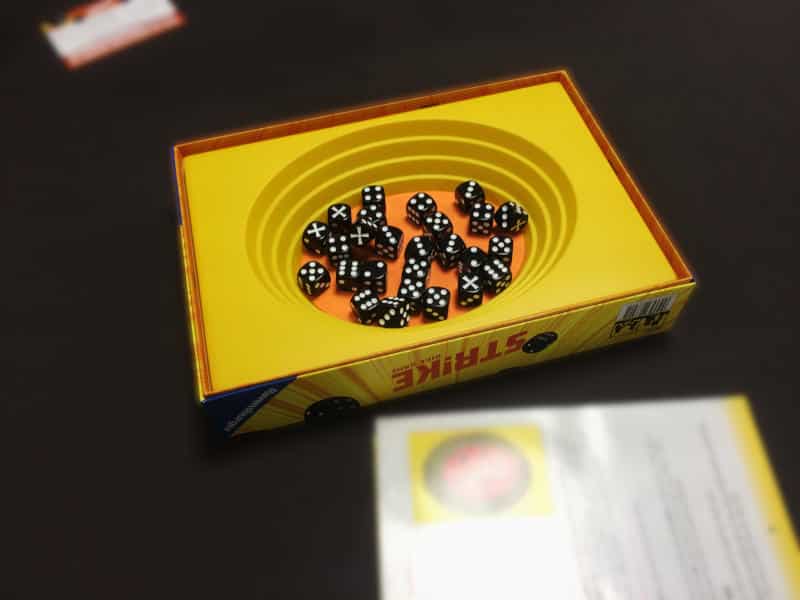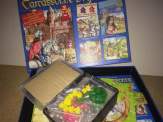I am a hater of air and a lover of compact design. What I mean by that is that I don’t like games where most of the box is empty, with components just floating around. I prefer it when the product design is clever and either has a good insert or otherwise makes everything compact. If a game goes the extra step and makes the box itself an integral component, then I’m super impressed. So in this article, I want to look at some examples that I think do it really well.
Listen to the Audio Version
Intro Music: Bomber (Sting) by Riot (https://www.
Tropical Night by Roa Music | https://soundcloud.
Music promoted by https://www.
Creative Commons / Attribution 3.0 Unported License (CC BY 3.0)
https://creativecommons.
Holding Boxes
Let’s start with games where the board game box, in its basic form, is incorporated into the gameplay without any modifications.
My favourite example is Mint Tin Mini Apocalypse from subQuark. The box of this game is already tiny and packed to the brim with components. However, this dice-rolling game goes the extra mile to make everything even more compact. Your goal is to get your meeples into the tin, which plays the role of a nuclear fallout shelter.
Of course, you could easily place your meeples in a different designated space on the table, without changing the game dramatically. So the box isn’t critical to playing Mint Tin Mini Apocalypse, but it does add an extra level of immersion that brings it all together, because the box is made from tin, which is a lovely thematic touch. As a real-time game, there is also a small amount of dexterity involved when you pick up your meeples and put them in the tin.
Going in the opposite direction, Ganz schön clever! has a box insert with a silver tray printed on it, where you place the dice you roll in this roll-and-write game. The printed tray isn’t indented or anything, so doesn’t really function as a useful dice tray. It’s more for show, but displaying the dice somewhere where everyone can see them is important in this game. So offering an option as part of the box design is a good idea. However, there is still too much air in the box for my liking.

Get yourself a wooden Tabletop Games Blog dice tray.
Each tray is the perfect size to roll your dice, and with the soft mat, it’s really quiet, while the wooden frame makes it wonderfully sturdy.
Clever Inserts
A halfway point of air and having a functional box is Str!ke. In this push-your-luck dice-rolling game, the insert represents the arena of a Roman amphitheatre, while the dice are the gladiators. So while the box is too big for the components, which are just a set of dice, it needs to be that size to allow for the game’s dexterity element to fully unfold. A smaller box wouldn’t really work here. Also, if you rolled the dice in a different dice tray, you would be playing a different game. The stepped edges around the foam-covered centre are critical to playing Str!ke properly.
Icecool goes a step further. Not only is the box itself part of the game, but there are more boxes inside that all link together to create the arena. Additionally, the boxes have cutouts through which you flick your penguins in this dexterity family game. Before you begin, you need to set up the boxes and connect them together, creating a giant playing space from a relatively small board game box. It is amazing to see how great the product design is here.
Burgle Bros 2 takes the idea of using the game box to the next level – literally. The box is suspended on four legs to create another playing area that’s directly above the ground-level playing area. So while in the original game tiles were laid out in grids side-by-side, even though they represented different floors of the same building, in the second version you now have the grids physically above each other, which makes it easier to know what’s on top of what.

Folding Boxes
The pinnacle of games that use the box as an integral game component is, of course, the Korean edition of Can’t Stop. Origami-style, the rectangular box folds out to make a triangular game board, showing the mountain that you’re trying to climb up. It’s absolutely genius. If you get the chance, you have to see it in action.
Not only is the box integral to gameplay, it’s also stuffed with components, leaving only enough space and breathable air for a small insect. It’s fantastic and I’m on the hunt for a copy, so that I can say I own this genius product design – and also to play it, of course – but mainly to have it.
While games like the Korean edition of Can’t Stop are rare and probably an extreme case of compact design that incorporates the game box as a critical component, the tradition of game boxes functioning as game boards goes back a long while.
There are many traditional games that you buy in a box that’s also the playing area. Backgammon is probably the most famous, but many of us will have got a Chess set at home that comes in a wooden box that holds the pieces and folds out to make the square checkerboard.
Of course, there are classic games that don’t even need a game box and often don’t require components. Mankala, for example, can be played by making indentations in the ground and collecting pebbles. So there is no need for you to make room on your board game shelf for a Mankala box.
What About You?
I wonder if you’ve played any of the games I’ve mentioned in this article. If so, which ones? Or have you played other games where the box is incorporated into gameplay? What is your favourite example? As always, please share your thoughts in the comments below. I’d love to hear what other games make clever use of the box.
For behind-the-scenes updates, branded merchandise, and more, please support the blog.
Useful Links
- Mint Tin Mini Apocalypse review: https://tabletopgamesblog.
com/ 2019/ 03/ 23/ mint-tin-mini-apocalypse/ - Str!ke review: https://tabletopgamesblog.
com/ 2022/ 12/ 17/ strike-saturday-review/
Audio Version
Intro Music: Bomber (Sting) by Riot (https://www.
Tropical Night by Roa Music | https://soundcloud.
Music promoted by https://www.
Creative Commons / Attribution 3.0 Unported License (CC BY 3.0)
https://creativecommons.
Playlist
These are the songs I listened to while I was writing this topic discussion article:





